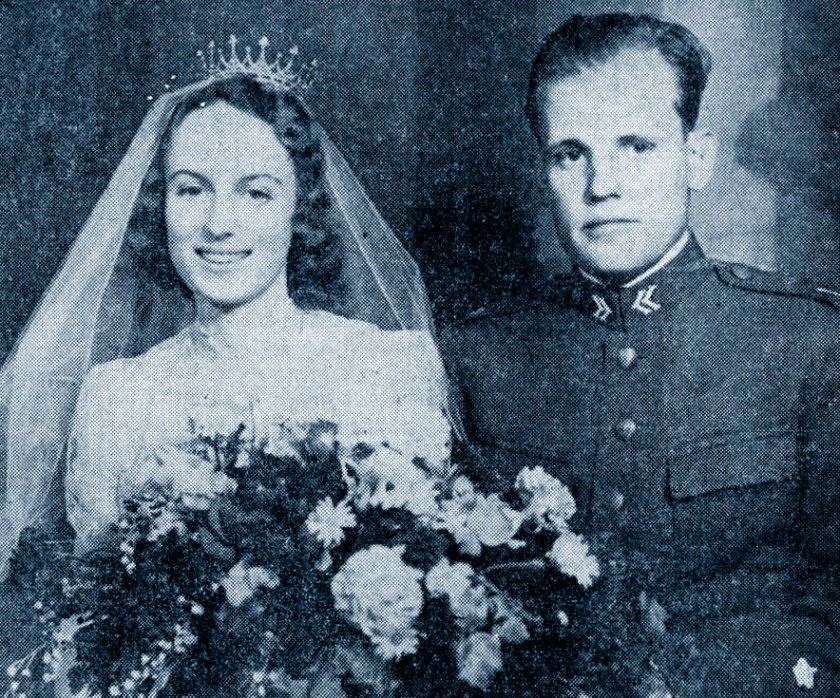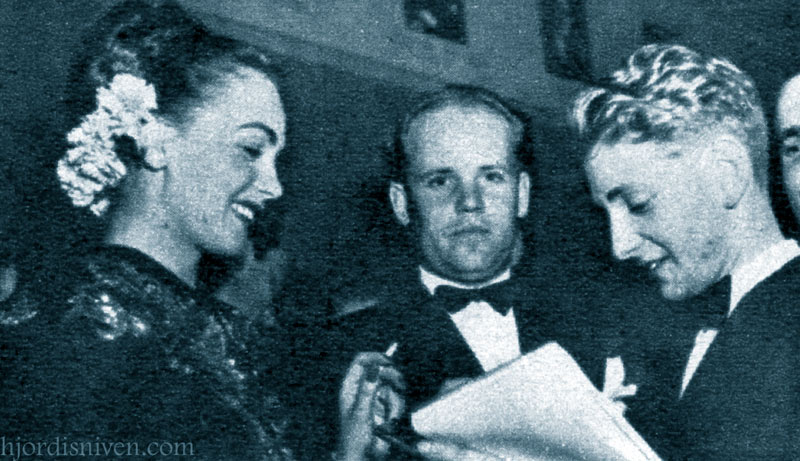
Carl Gustaf Arend Benjamin Tersmeden was born on 10th February 1917 into a prominent and wealthy Swedish family. His father was a high-ranking lawyer and a member of the Swedish nobility. His mother came from a family of industrialists. Her father, Arend Versteegh, was one of Sweden’s richest men.
Adult Carl Gustaf became known in Stockholm as a very rich man-about-town, then a very rich businessman, and finally as Sweden’s most famous playboy. The label at the forefront during his time with Hjördis was simply “very rich”.

During the Second World War, Carl Gustaf was a “Löjtnant” in the Swedish Air Force Reserve, in charge of an anti-aircraft battery. He also worked for the Swedish airline AB Aerotransport / ABA (later part of SAS), which astonishingly managed to maintain a European network throughout, running services to Scotland, German-occupied Paris, Moscow – until 1941, and even Berlin into 1945. Part of AB’s British service, operated at some risk, was ferrying ball bearings, crashed Allied air-force crews and Norwegian resistance operatives to the UK.
By the time Carl Gustaf began to take an interest in Hjördis, he already had one marriage behind him, to mill and landowner’s daughter Ingegärd Beck-Friis. Their engagement was announced in May 1939. The marriage lasted from June 1940 to February 1943.

It’s probably a false impression, but the look on Carl Gustaf’s face in their wedding photo could be described as “extreme doubt”. Ingegärd looks a lot happier. That said, she remarried only three months after their divorce to Swedish diplomat Ingemar Hägglöf.
Despite Hjördis writing that she was won over by Carl Gustaf’s impromptu visit to Leja with an armful of flowers, their relationship remained pretty open for some time. According to Allas magazine, that was despite Cal Gustaf’s best efforts: “He spoiled her and overwhelmed her with presents, but he couldn’t catch Hjördis so easily.”
“She started to be called ‘Tersmeden’s figurehead’ because she spent so much time on his yacht, dressed in chic beach and sailing clothes. However, it was whispered in Stockholm society circles that she had already turned him down twice.”

It seems she turned down a more serious commitment – possibly because life was going so well at the time.
“I still had other male friends and admirers who asked me out,” Hjördis wrote, “even though it was Carl Gustaf Tersmeden whom I thought best of and liked being with the most. Through him, I attended a swirl of happy parties, met many people, made new friends, and opened up new horizons.”
Moving to the French department
“That was when I was offered employment at NK’s Franska (French) department. I had a good time at Leja, but I would get better pay and working conditions at NK. So, I took the offer and never regretted it.”
An American visitor in 1939 described NK as “a very modern store – spacious lunch rooms, smoking rooms, roof garden, theatre booking office, manicure and hairdressing salons, Elizabeth Arden treatment salon, post and telegraph offices, doctor’s office and estate agency. The store is complete like Harrods of London, Printemps of Paris or Wanamakers of New York.”
What Hjördis was offered was, in effect, a promotion. NK’s Franska department held exclusive Swedish rights to make and sell such famous French names as Chanel and Christian Dior.
The manager from 1907 until its closure in 1966 was Kurt Jacobsson, who named Hjördis his favourite model, even ahead of Greta Gustafsson (Garbo), who had quickly changed sides from model to customer.

“The rooms were unusually nice,” Hjördis remembered. “The girls had a big dressing room where we could relax when we weren’t working. And it was so much easier to have hair styling, facial care and everything else under one roof. I also enjoyed working with my new colleagues, most of whom I already knew. ”
As well as having male admirers, Hjördis drew the admiration of her fellow models or ‘mannequins’ as they were known at the time. Star model Kim Andersson (who married in 1946 and maintained her fame as Kim Söderlund) also moved from Leja to Franska and remembered Hjördis as a dazzling model and a good friend.
“We had a lot of fun and laughed and giggled together as girls do. She was an amazingly skilful model. She used these long, rapid movements that highlighted the clothes in exactly the right way. Her movements were natural. And she created an atmosphere as if she was very proud of every garment she wore.”
Hjördis’ profile steadily increased, and she became Sweden’s most famous fashion and photo model. While at Leja in 1942, she was already appearing in newspaper and magazine fashion articles. At Franska, she was pictured and name-checked on the front covers of magazines from her arrival in September 1943 onwards, including Vecko Journalen (Weekly Journal), Svensk Damtidning, and Vårt Hem (Our Home).
Over an intensive four-year period, Hjördis claimed to have appeared on around 50 magazine covers. Vecko Journalen later remembered her as “40s Sweden’s grandest star model”.
Here’s a slide show of Hjördis Genberg fashion photos, mostly from 1943 to 1944.
“Things worked out fine,” Hjördis recalled of her early days at Franska. “It was just that the most important thing, the thing that meant most to me, had gone askew…”
The Chilean Nightingale

“The famous international star Rosita Serrano arrived in Stockholm and took the entire capital by storm. She would’ve liked to have done the same for me, but the thing was that she had also taken Carl Gustaf by storm. He was completely charmed by her exotic beauty, glamour, and fame. Tersan always had a soft spot for international celebrities, a weakness in which he was not alone.”
In January 1943, the Chilean-born singer and musician Rosita Serrano arrived in Sweden from her adopted homeland, Nazi Germany, flown in by the colourful AB Aerotransport pilot Carl Gustaf von Rosen. Rosita had been a massive star in Germany for some years, earning the title ‘The Chilean Nightingale’.
She quickly set out on a 25-date tour of Sweden, throwing in a one-off performance in Helsinki in March. Sweden was neutral, and Finland was a German ally on The Eastern Front. However, Rosita firmly believed that her music was for everyone – “Art can never be mixed with politics”, she said [and was wrong].
While in Sweden, Rosita Serrano was under observation by the OSS (precursors of the CIA), who later questioned her chauffeur about her activities during a short return to Berlin in March-April 1943. Nothing untoward was found. Her Berlin address was recorded as 21 Jenaer Straße. The address now bears ‘stumble stone’ plaques commemorating Jewish residents who were murdered in 1941 during the Holocaust.

Rosita performed additional concerts in Sweden during the summer and autumn of 1943 before it was announced in mid-September that she would soon be returning to Germany: “for new triumphs on the continent”. However, any return quickly became out of the question.
On 20th October, she was announced as the headline act for a special Stockholm charity show in aid of “Danish” refugees. Also on the bill was Danish-Jewish actor Jakob Texiére.
Rosita Serrano’s willingness to get involved must have been enough to alert her high-ranking Nazi fan base in Germany. When the concert’s promotional advert was released on 21st October, her name was no longer listed. In her place was the opera singer Frantz Rabinowitz. (This doesn’t mean that she did not perform. Her family have claimed that she performed “clandestine” shows for Jewish refugees). Either way, the damage was done.
Frantz Rabinowitz had only just escaped from his homeland. After news leaked on 29th September 1943 that the German occupiers were about to arrest Denmark’s Jews, he was smuggled onto a ferry bound for the Danish island of Bornholm. As it passed near the Swedish coast, he jumped overboard and swam ashore, illustrating his dreadful desperation to escape. He was one of 7,220 Danish Jews rescued from the Nazis.

Despite Rosita being out of reach, an arrest warrant was issued in Berlin on 5th November 1943, accusing her of espionage. The playing of her music in Germany was banned. She was now stuck in Stockholm and referred to in the local press as Sweden’s “fugitive number one”.
(The OSS continued to bark up the wrong tree. In December 1943, they were informed that Rosita intended to travel to Turkey “no doubt on behalf of German Intelligence”. This was followed by a report in January 1944 that she wanted to return to Chile: “The reason for this change of plan is unknown”.)
Fast forward to 1945, and Rosita was still trying to reach Chile: “I have a country house twenty minutes out of Stockholm surrounded by a big park on the banks of the river Mellan,” she wrote in 1945. “I keep on being lucky in my artistic career. I have travelled all over Sweden and Finland with my guitar, but these countries are very small…”

Check out the fantastic Liberty Lady blog for more about Rosita Serrano and her adventures in Sweden.
“I think what enchanted Tersan most about Rosita was her music,” Hjordis wrote. “Tersan himself was deeply musical, with real talent that he unfortunately never revealed. (Carl Gustaf’s brother Gerhard was a successful jazz composer, referred to in the press as ‘the Swedish Gershwin’) He was too busy and restless. Rosita was not only a beautiful woman, she was also an exquisite artist. She was all music – and this became too much for Carl Gustaf Tersmeden to be able to resist. For a time.” The time in question may have included a sizeable chunk of 1944.
“For what it was, the romance between him and Rosita ended, and everything started again between us. And yet, it’s not really the same as before. For now, we had become aware that our feelings for each other were more serious than a flirt or a romantic adventure. Carl Gustaf asked me to marry him, and I said yes.”
(Rosita Serrano never managed to shake off her links with Nazi Germany. She died in poverty in her native Chile in 1997).
Next page: Something big and demanding, 1945